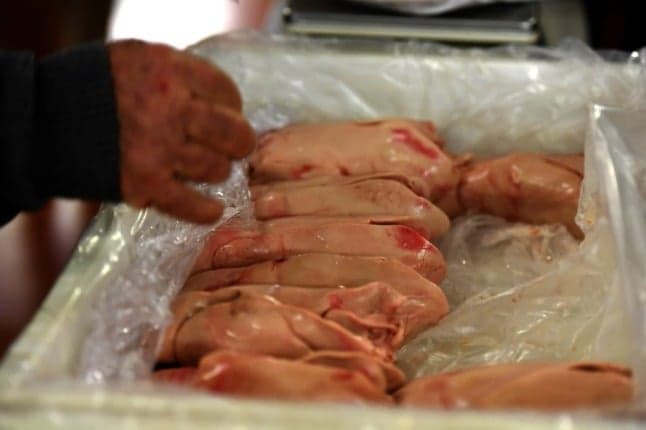French schools ban foie gras Christmas lunches

Local authorities in several areas of France have banned the traditional serving of foie gras in school canteens over Christmas.
Many French schools have foie gras on the Christmas lunch menu. It is dished up in a variety of ways - either as a stuffing or as a spread.
But three towns (Grenoble, Strasbourg and Villeurbanne) governed by the Green party have banned the product in school canteens and for official town-hall functions. The move comes after years of pressure from the animal rights group, PETA.
READ ALSO Do French kids get the best school lunches in the world?
Sandra Krief, a city councillor in Grenoble for the Parti Animaliste who also campaigned for the ban, tweeted that the production of foie gras was "one of the worst practices or 'traditions' as far as animal cruelty is concerned."
"Foie gras is a shameful French tradition that should be abolished like bullfighting," she continued.
READ ALSO Meet the French Animal Party candidate running for president
France makes about two thirds of the world's foie gras, produced by force-feeding ducks or geese until the develop the distinct 'fatty liver'.
In an interview on Sud Radio, Marie-Pierre Pé, director of France's Inter-professional Committee of Foie Gras makers hit back, saying the ban was "scandalous".
"Anyone who goes to meet producers understands that the fattening comes towards the end of the animal's life. It totally respects the life of birds, which are there to produce this famous foie gras that the whole world is jealous of," she said.
"There is more and more attention being paid towards the wellbeing of the animals."
READ MORE French mayor's foie gras ban prompts fury from farmers
PETA is now campaigning to have foie gras scrapped from menu at official town hall functions in other cities, including Bordeaux, Lyon, Marseille and Montpellier.
The French delicacy has been under attack around the world for years. The EU parliament called on member states to ban the practice of force feeding this summer - and has banned the product from official events in the Strasbourg parliament building. In the United States, California has banned the sale of foie gras produced with force feeding. The British government plans to do the same.
Michelin-starred chef, Alexis Gauthier, has a potential solution that could reconcile animal rights activists and foie gras lovers: Faux gras - a plant based alternative. You can read the recipe HERE or watch the tutorial.
READ MORE Lab-grown 'foie gras' cannot use product name, says French food producers group
Comments (1)
See Also
Many French schools have foie gras on the Christmas lunch menu. It is dished up in a variety of ways - either as a stuffing or as a spread.
But three towns (Grenoble, Strasbourg and Villeurbanne) governed by the Green party have banned the product in school canteens and for official town-hall functions. The move comes after years of pressure from the animal rights group, PETA.
READ ALSO Do French kids get the best school lunches in the world?
Sandra Krief, a city councillor in Grenoble for the Parti Animaliste who also campaigned for the ban, tweeted that the production of foie gras was "one of the worst practices or 'traditions' as far as animal cruelty is concerned."
"Foie gras is a shameful French tradition that should be abolished like bullfighting," she continued.
READ ALSO Meet the French Animal Party candidate running for president
France makes about two thirds of the world's foie gras, produced by force-feeding ducks or geese until the develop the distinct 'fatty liver'.
In an interview on Sud Radio, Marie-Pierre Pé, director of France's Inter-professional Committee of Foie Gras makers hit back, saying the ban was "scandalous".
"Anyone who goes to meet producers understands that the fattening comes towards the end of the animal's life. It totally respects the life of birds, which are there to produce this famous foie gras that the whole world is jealous of," she said.
"There is more and more attention being paid towards the wellbeing of the animals."
READ MORE French mayor's foie gras ban prompts fury from farmers
PETA is now campaigning to have foie gras scrapped from menu at official town hall functions in other cities, including Bordeaux, Lyon, Marseille and Montpellier.
The French delicacy has been under attack around the world for years. The EU parliament called on member states to ban the practice of force feeding this summer - and has banned the product from official events in the Strasbourg parliament building. In the United States, California has banned the sale of foie gras produced with force feeding. The British government plans to do the same.
Michelin-starred chef, Alexis Gauthier, has a potential solution that could reconcile animal rights activists and foie gras lovers: Faux gras - a plant based alternative. You can read the recipe HERE or watch the tutorial.
READ MORE Lab-grown 'foie gras' cannot use product name, says French food producers group
Join the conversation in our comments section below. Share your own views and experience and if you have a question or suggestion for our journalists then email us at [email protected].
Please keep comments civil, constructive and on topic – and make sure to read our terms of use before getting involved.
Please log in here to leave a comment.